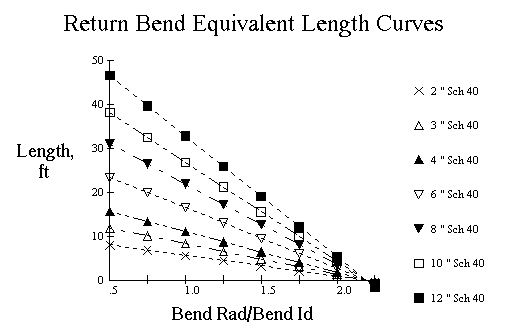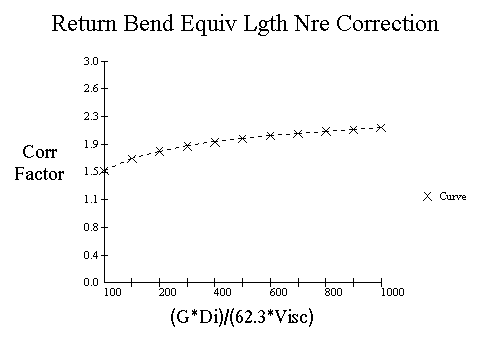In Tube Pressure Drop
The intube pressure drop may be calculated by any number of methods available today, but the following procedures should give sufficient results for heater design. The pressure loss in heater tubes and fittings is normally calculated by first converting the fittings to an equivalent length of pipe. Then the average properties for a segment of piping and fittings can be used to calculate a pressure drop per foot to apply to the overall equivalent length. This pressure drop per foot value can be improved by correcting it for inlet and outlet specific volumes.
Friction Loss:| Dp = Pressure drop, psi |
| di = Inside diameter of tube, in |
| G = Mass velocity of fluid, lb/sec-ft2 |
| Vlm = Log mean specific volume correction |
| F = Fanning friction factor |
| Lequiv = Equivalent length of pipe run, ft |
| V1 = Specific volume at start of run, ft3/lb |
| V2 = Specific volume at end of run, ft3/lb |
| Vi = Specific volume at point, ft3/lb |
| Tf = Fluid temperature, °R |
| Pv = Press. of fluid at point, psia |
| MWv = Molecular weight of vapor |
| Vfrac = Weight fraction of vapor %/100 |
| rl = Density of liquid, lb/ft3 |
The Moody friction factor, for a non-laminar flow, may be calculated by using the Colebrook equation relating the friction factor to the Reynolds number and relative roughness. And the Fanning friction factor is 1/4 the Moody factor. For a clean pipe or tube, the relative roughness value for an inside diameter given in inches is normally 0.0018 inch.
With this, we can calculate the factor,
Equivalent Length Of Return Bends:
The equivalent length of a return bend may be obtained from the following curves based on Maxwell table and can be corrected using the Reynolds number correction factor.
| FactNre = Reynolds number correction |
| Lrb = Equivalent length of return bend, ft |

Reynolds Correction:

Where,
| G = Mass velocity, lb/sec-ft2 |
| Di = Inside tube diameter, in |
| Visc = Viscosity, cp |
Now that we have all the details described, we can calculate the pressure drop for some typical heater coils.
Disclaimer:
The formulas and correlations presented herein are all in the public domain and are to be used only as a learning tool. Note that any product, process, or technology in this document may be the subject of other intellectual property rights reserved by sponsors or contributors to this site. This publication is provided as is, without any warranty of any kind, either expressed or implied, including, but not limited to, the implied warranties of fitness for a particular purpose, or non-infringement.
The formulas, correlations, and methods presented herein should not be considered as being recommended by or used by the sponsors of this site. The purpose of this site is educational and the methods may or may not be suitable for actual design of equipment. Only a fired heater design engineer is qualified to decide if a calculation or procedure is correct for an application.